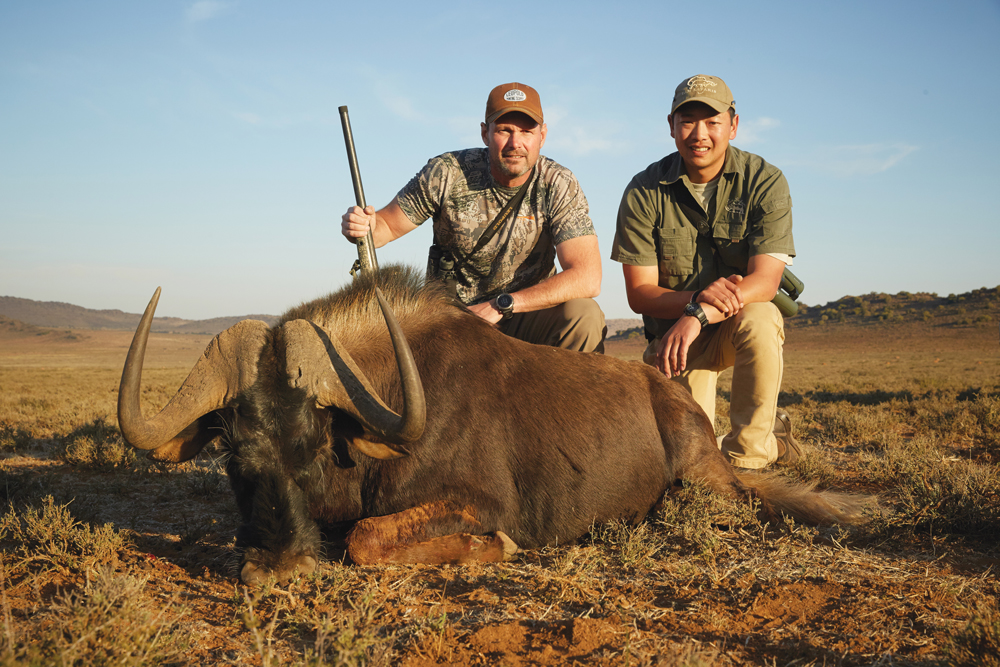Central and southern Africa are truly magical regions of the world. My first safari was to the Eastern Cape of South Africa in 2005, and I have been utterly hooked on the adventure, people and bountiful wildlife populations ever since.
As someone who has been lucky enough to work in the firearms and outdoor industries for a long time, it also became apparent to me that there are few better places for putting newly designed equipment through its paces.
I have been eagerly planning to travel to Mozambique with five friends in pursuit of Cape buffalo, sable and other legendary species. It was going to be my next great African adventure. But a pleasant surprise came when I was assigned to travel over to the mountains of the Eastern Cape to help test a new rifle and scope from two of America’s most storied manufacturers. I would be going to Africa twice in the same year — it’s apparently true that getting older isn’t all bad. It would have been silly of me to dream of such a thing as a young hunter chasing deer in the woods of northern Virginia.
James Debney, Golden Ring of Freedom member and CEO of Smith & Wesson (which owns Thompson/Center), and Bruce Pettet, his counterpart at Leupold & Stevens, would share camp with me. The equipment to be tested would be the new T/C Compass rifle, chambered in .30-06 and Leupold’s new VX-3i scope, designed from the ground up to excel in the low-light conditions that offer hunters so many of their shooting opportunities.
I only learned of the trip about three weeks out. That might be a bad thing in some ways, as I’m very meticulous about my equipment, especially the rifle that I’m going to use. I was concerned that I might not have the time necessary to get everything working to my standards, but the VX-3i and T/C Compass arrived at my gun dealer’s shop just a few days later.
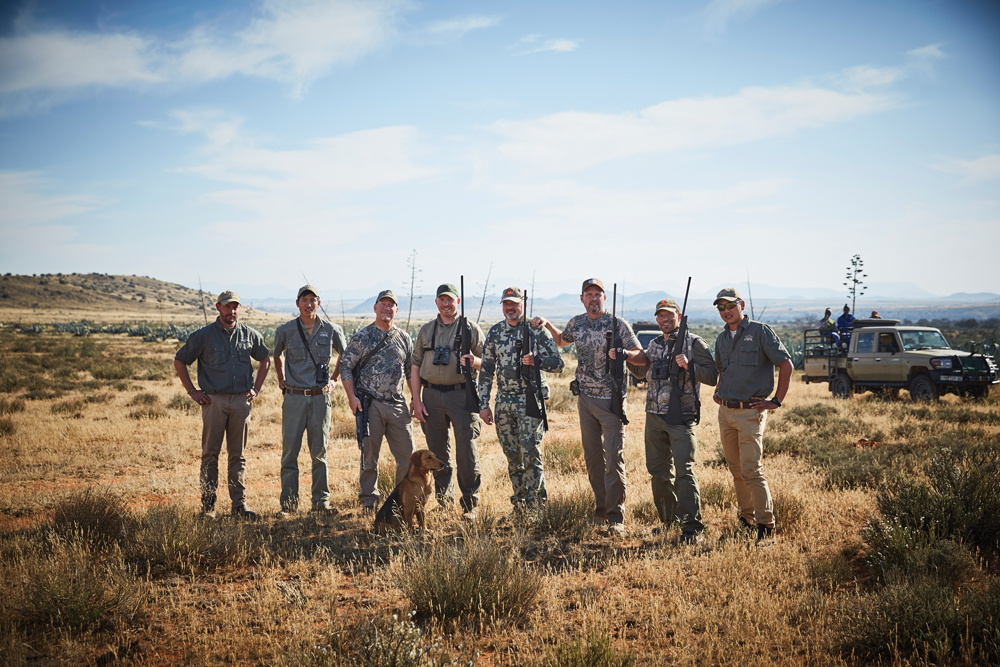
Left to right: Len Durandt, PH Stephen Tam, Scott Cain, Chris Sprangers, James Debney, Bruce Pettet, the author, and PH Peter Tam.
As I told Debney when he got to camp, I really didn’t want to like the T/C Compass because I had just spent a princely sum on a custom hunting rifle that I needed to believe was worth the price. But when I took my T/C Compass to the range, it shot at least as well as my outrageously expensive rifle. I proceeded to shoot two three-shot groups at 100, 200, and 300 yards. All six groups were 1 MOA or better, as T/C promises every buyer. The last group was the stunner, though. It was at 300 yards and measured just under one inch, barely outside of the bull at one o’clock.
It was a punch to the gut, but I was happy to see a product of such quality at such an amazingly affordable price. Debney later told me as we hunted together: “We set out to design a rifle that would exceed expectations in terms of accuracy, reliability, and functionality, but that would not be hard on the budgets of America’s hard-working hunters and their families.”
I would say they hit their mark.
Unlike many Americans, Debney, who is from Great Britain, hasn’t been a lifelong hunter. He only began hunting after becoming head of storied gunmaker Smith & Wesson.
“My motivation for hunting was pragmatic at first,” he told me. “Smith & Wesson owns and operates T/C, a line of great firearms. If I was going to effectively run a company that makes firearms used by hunters, I needed to know hunting. It’s the way I choose to lead.
“I saw the passion in my friends and employees who pursued game and knew there was no way for them to adequately convey to me the nuances and emotion associated with an activity that archaeologists say extends back at least one million years.”
As it turned out, James Debney was onto something.
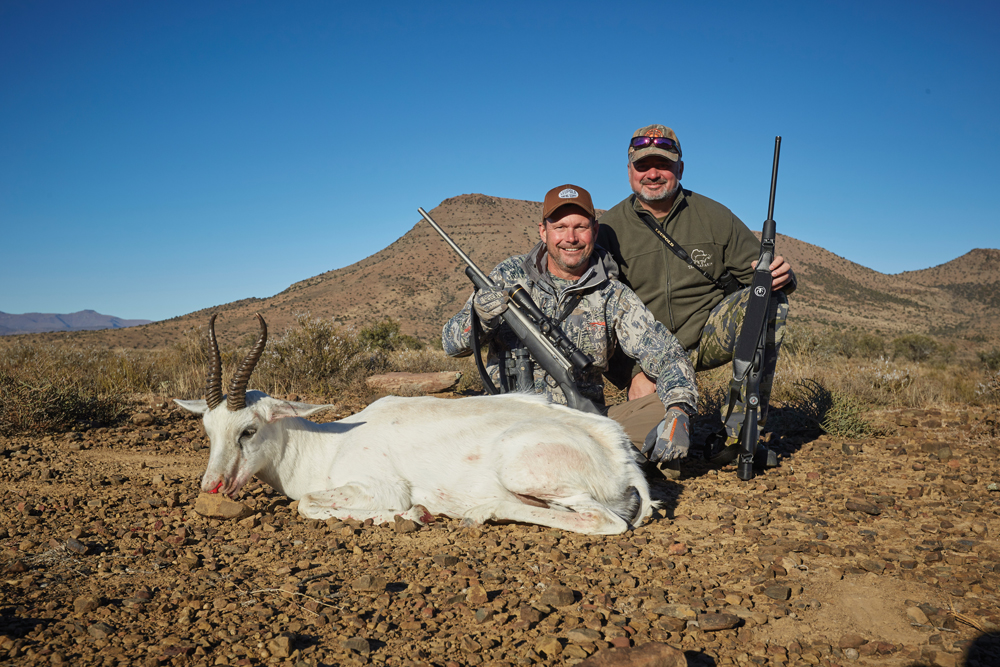
Bruce Pettet (left) and James Debney with a springbok.
“I really had no idea at the time how right I was about this,” he said. “That first hunt of my life — going after feral hogs in Florida in 2009 — activated something deep within me that I cannot deny. I have now traveled to Alaska for moose, New Mexico for elk, New Zealand for stag, and Africa for a wide variety of species.”
Hunting with Debney and Pettet, while being fortunate enough to test their new products, was truly a pleasure. On the hunt, I liked everything about the T/C Compass, especially the way that it carried and handled. Its five-round, detachable, flush-fit rotary magazine was a nice touch, but it was unnecessary since the rifle shot so well. The black wildebeest, vaal rhebok, steenbok, red lechwe, and mountain reedbuck that found their way into my crosshairs all went to feed us and the locals around camp.
Speaking of crosshairs, two of my five opportunities came at last light. Both were right at 200 yards, and while preparing to take the shot from shooting sticks, my experience told me that I needed to turn down the magnification in order to allow more light to be gathered. As I began to run the magnification down, I realized that the effort was unnecessary with this new VX-3i. I ultimately took both shots at full 14 power, which is pretty remarkable.
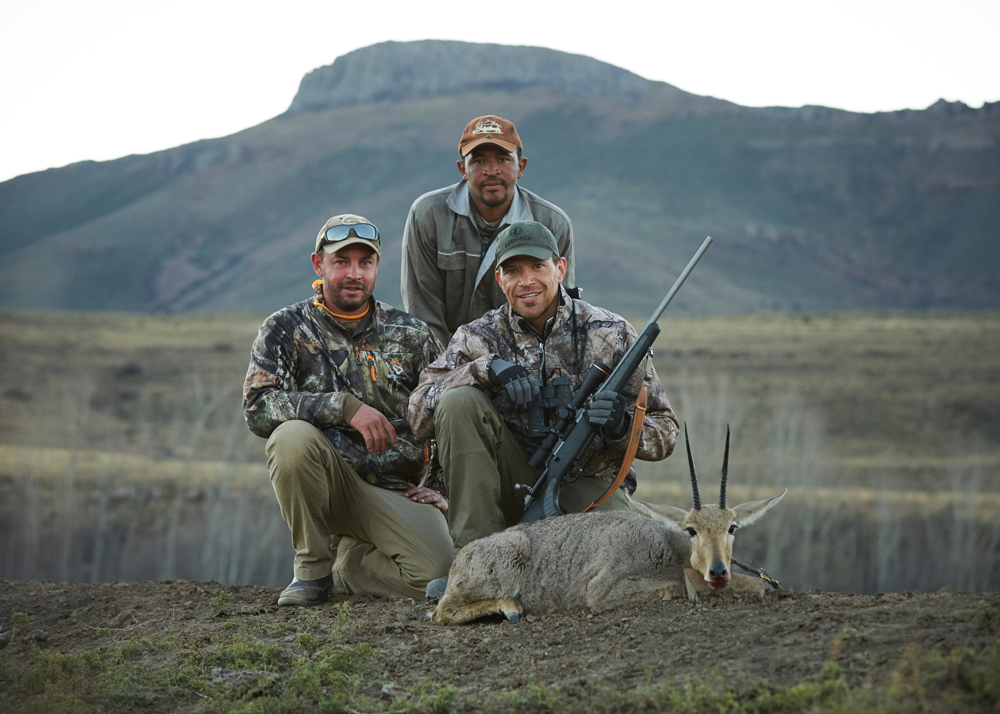
Len Durandt (left), the author (right), and the camp’s tracker with a Vaal rhebok.
The exceptional hunting that Africa has to offer is something I will cherish for the rest of my days. But another is the conversation hunters enjoy around the campfires. On this particular trip, some of the recent controversies associated with hunting in Africa led Debney, Pettet, me, and our friends in camp to barrage our South African hosts at Tam Safaris with questions concerning the essential role hunting plays in the battle to preserve and propagate Africa’s many dozens of game species.
There is a line in Kevin Robertson’s book, The Perfect Shot, that is so simple it seems it couldn’t possibly describe the way things really are. But it does. The line is, “If it pays, it stays.”
What this means is that if property owners and indigenous peoples see there is more benefit associated with wildlife populations existing than not, they will work to preserve them. Almost always, this benefit is measured in currency.
A good example of this is that many species in South Africa were brought to dangerously low levels by farmers and ranchers in the 1970s. They viewed wildlife as nothing but voracious consumers of the crops they worked so hard to grow, or as competition with their cattle and sheep. This dangerous mindset began to change as landowners realized they could financially benefit by nurturing game populations and allowing hunters (mostly foreign) to pursue them in a sustainable manner.
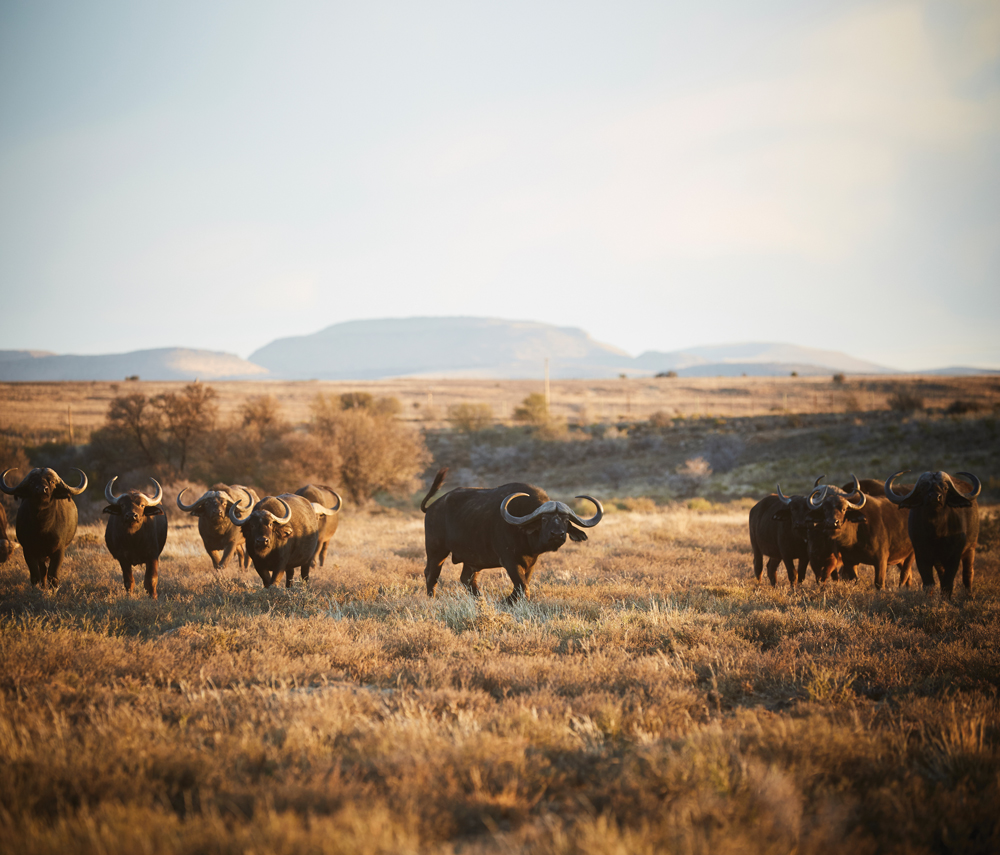
Staring down a herd of temperamental Cape buffalo.
They found that there were ways to allow wildlife to successfully coexist with ranching and farming. In many cases, landowners were eventually able to move entirely to hunting operations. Domestic animals such as sheep and cattle, were replaced by impala, springbok, kudu, wildebeest, and gemsbok. Wildlife began to pay, and because of this, these animals remain today. In fact, like wildlife populations in the United States, populations in South Africa are arguably healthier than they were in the last century.
Tam Safaris has its own, much more recent story. Brothers Stephen and Peter Tam own and operate the hunting operation in an area for breeding and caring for a robust white rhino population. Just before we arrived in camp, the Tams had sold nearly their entire herd because caring for their rhinos became too much of a liability — and too dangerous. It was a terribly emotional decision for them in light of all they had done for these great beasts.
This year alone they had already lost five rhinos to sophisticated poaching operations. The danger of coming across poachers while out on their property — and the expense of sustaining year-round anti-poaching patrols — simply became too much to bear. Sustainable rhino hunting, which has for so long funded their conservation efforts, is being radically discouraged by social pressures and government regulations. Rhinos have stayed because they paid, but this successful model is being turned on its head by the emotional and uneducated who believe they are doing good.
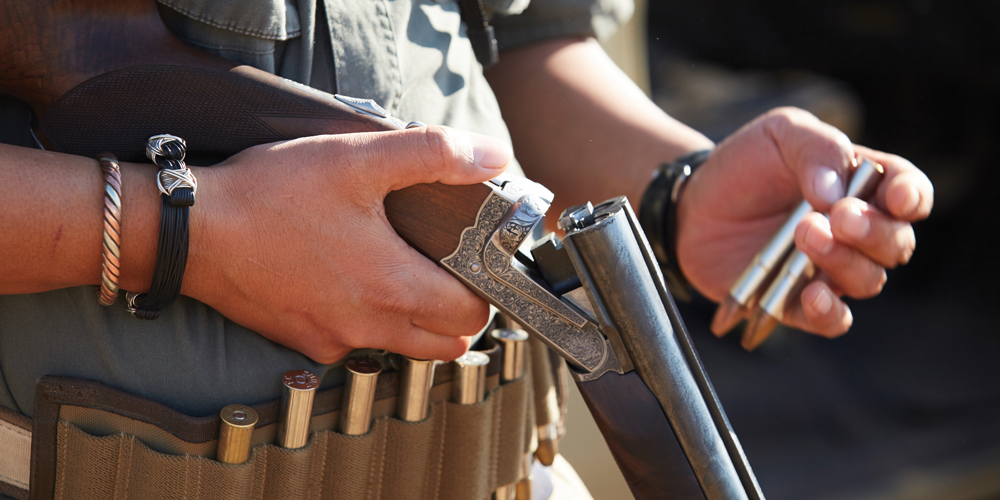
Keeping a big double rifle loaded is a good idea when dangerous game is around.
The Tams also explained the new crisis that lions will face as a result of action taken by the U.S. Fish and Wildlife Service. For all intents and purposes, the importation of legally hunted lion trophies into the United States has been halted.
Since roughly 80 percent of the licensed lion hunters in Africa are Americans, nearly all of this hunting will come to an end because of the importation ban. Consequently, lions will be seen by landowners as nothing but a liability. Not only are they dangerous, they eat all of the other high-dollar species, such as roan and sable, that can still be hunted.
The new regulation has destroyed the landowner incentive to accommodate lions. Sadly, because of the ban, there is nothing to stop landowners from making the not-so-complicated economic and safety decision to kill all of the lions on their properties.
A similar story is told in Africa’s central countries. Without sporthunting, the popular sentiment is that the only good lion is a dead one. The big cats are not seen as the cute, cuddly critters depicted in Hollywood blockbusters. They are a danger and often prey on cattle, goats, and sheep. Some indigenous populations poison lions to remove them from the picture. The math is not complicated in Africa’s villages: Humans are more important than animals — no ethical calculator necessary.
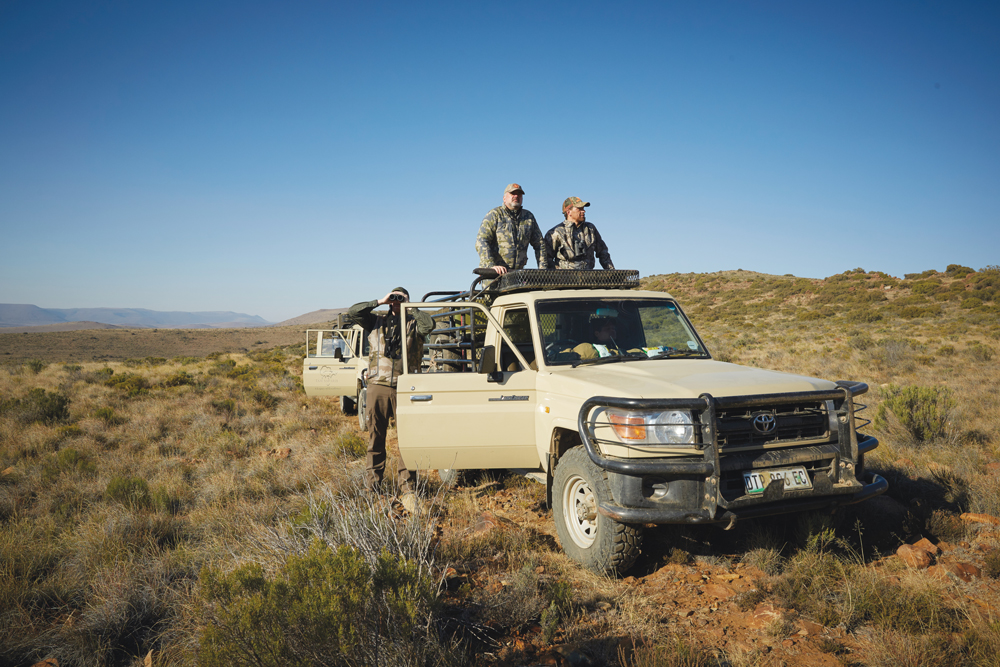
S&W CEO James Debney (left) and the author scan the rolling hills of south Africa’s Eastern Cape for game.
When hunting is allowed and encouraged (in other words, when no importation bans are in place), the locals experience enormous societal pressures not to eradicate lions. Healthy, huntable lion populations bring real money into local economies by creating jobs for trackers and hunting camp staff, as well as payment of government hunting fees. The latter are often directed toward conservation efforts and village infrastructure improvements. Additionally, the game meat generated from safaris often goes to local villagers, providing an essential source of protein in areas all too deficient in it.
The hunting in Africa is beyond imagination, but the education provided by the people on the ground there is also life-changing. Too many Americans believe that one more hunter-killed lion means the simple math of one less lion on the planet. This thinking could not possibly be further from the truth. The hard-learned lessons speak for themselves: Where hunting bans have been imposed on species that were traditionally hunted, things have not ended well for those species — or for humans.
It is time for emotion to be set aside when it comes to wildlife conservation, especially in Africa. It might sound cold and callous, but the old line I first read in The Perfect Shot is the immutable truth. Regulated hunting in North America saved wildlife here, and the same can be the savior in Africa — even if the motivations are different.
GEAR TEST
When Smith & Wesson CEO James Debney heads to Africa, he sometimes has a tough time limiting himself as to which guns he takes on the long trip across the Atlantic. That’s understandable since Thompson/Center produces more than a few fine options. Occasionally, Debney also totes a large-bore Smith & Wesson revolver in a chest rig. His friends might call him many things, but “under-gunned” isn’t one of them.
In Leupold’s new VX-3i, the company’s innovative product design team has created the new standard with regard to low-light performance by a riflescope. Thanks to the new Twilight Max Light Management System technology, the days of missed last-minute shot opportunities, especially on overcast days, might be a thing of the past.
Thompson/Center’s new bolt-action Compass, chambered in the venerable .30-06, is an outstanding rifle for African plains game. Incredibly, the model’s MSRP is only $399—stunning when you take into account that it has a 1-MOA accuracy guarantee, a threaded barrel, five-round, flush-mount rotary magazine, and a pillar-bedded stock.
While in the valleys, mountains, and plains of the Eastern Cape, Debney and his friends used Hornady’s new Precision Hunter ELD-X ammunition. The ELD-X bullet has a revolutionary new Heat Shield tip, enabling the match-grade bullet to retain its shape in flight and expand dramatically and reliably on game.
Editor’s Note: This article first appeared in the 2017 Jan./Feb. issue of Sporting Classics. Photography by Michael Ives.

